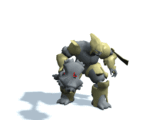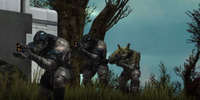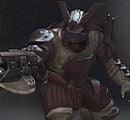Jiralhanae: Difference between revisions
From Halopedia, the Halo wiki
m (Reverted edits by Gutsy Kyle (Talk) to last version by General5 7) |
|||
| Line 299: | Line 299: | ||
==Gallery== | ==Gallery== | ||
<gallery | <gallery> | ||
File:1207645687 1166618976.jpg|A Brute Chieftain wielding an [[Energy Sword]] (this instance was never actually used as default in ''[[Halo 3]]'', but rather in the video ''[[Halo 3 ViDoc: Et Tu, Brute?|Et tu Brute]]''). | File:1207645687 1166618976.jpg|A Brute Chieftain wielding an [[Energy Sword]] (this instance was never actually used as default in ''[[Halo 3]]'', but rather in the video ''[[Halo 3 ViDoc: Et Tu, Brute?|Et tu Brute]]''). | ||
File:Halo3 Brutes.png|The ''[[Halo 3]]'' CGI TV trailer "[[Starry Night]]" depicts multiple Brute variants that appear in ''Halo 3''.<ref>http://carnage.bungie.org/haloforum/halo.forum.pl?read=765343</ref> | File:Halo3 Brutes.png|The ''[[Halo 3]]'' CGI TV trailer "[[Starry Night]]" depicts multiple Brute variants that appear in ''Halo 3''.<ref>http://carnage.bungie.org/haloforum/halo.forum.pl?read=765343</ref> | ||
| Line 308: | Line 308: | ||
File:Halo Reach Brute Pack.png|A pack of Brutes in the ''[[Halo: Reach]]'' [[Firefight]] trailer. | File:Halo Reach Brute Pack.png|A pack of Brutes in the ''[[Halo: Reach]]'' [[Firefight]] trailer. | ||
File:BestiarumBrute.jpg|A Jiralhanae as seen in the [[Bestiarum]]. | File:BestiarumBrute.jpg|A Jiralhanae as seen in the [[Bestiarum]]. | ||
</gallery> | </gallery> | ||
Revision as of 08:50, June 25, 2010
Template:Ratings Template:New Content
| This article does not meet the wiki's general standards and/or standards on layouts. You can help by cleaning this article. |
Template:Covenant Species Infobox
- "We are the Chosen Carriers of the Flame!"
- — Tartarus, the last known Chieftain of the Jiralhanae
The Jiralhanae (Latin, Servus ferox, translated to "Wild Slave"[1]), also known as Brutes, are the newest members of the Covenant. They are a large, bipedal, ape-like species from Doisac. After the Kig-yar, the Jiralhanae and Unggoy were the second two Covenant species encountered by humans. The Brutes have a profound hatred of the Sangheili, unmatched by any other feud within the Covenant, fired by the Jiralhanae's natural aggressive nature and the Sangheili's attitudes of superiority.
The Jiralhanae have been part of the Covenant since before the destruction of the UNSC agricultural colony on Harvest[2], and were always feared by the Sangheili for their monomaniacal behavior. The Jiralhanaes' plans to seize power over the Sangheili began with their alliance with the High Prophet of Truth during the Battle of Harvest and continued to gain headway until the eventual splitting of the Covenant. They eventually took the role of the Prophets' Honor Guards from the Sangheili after the Sangheili failed to prevent the assassination of the High Prophet of Regret by the Master Chief, finally culminating with the Jiralhanae replacing the Sangheili as the leaders of the Covenant Military.
They are rated a Native Tier 4/Adopted Tier 2 species by the Forerunner Technological Achievement Tier scale.[3]
History
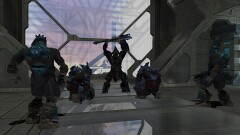
Despite their savagery, Brutes have proved intelligent enough to achieve spaceflight and space-faring status, though their warlike nature meant they quickly collapsed into civil war, and quickly afterward, fell back to their former pre-space status and learn nothing from the experience. The Brutes had recently concluded a mechanized war of attrition in which the many Master Packs fought and pummeled each other back to a pre-industrial state. When the Covenant discovered them in 2492, they had just rediscovered radio and rocketry.[4] In their primitive state they were quickly defeated and absorbed into the Covenant.
Their warrior culture makes them formidable opponents, even for Spartans, and they were incorporated into the Covenant as fierce guards for the Prophets and heavy infantry.
Brutes are obviously carnivores, given their fearsome fanged jaws and propensity for violence. It has been stated that they feed on the flesh of their enemies, such as the Humans they face in battle, and have been seen eating the meat of a Thorn Beast, apparently considered a delicacy among Brutes.[5] They have once stated they would have gladly devoured the Arbiter, had they been allowed[6].
As part of the Covenant, Brutes were required as a prerequisite to convert to the Prophets' religion of worshiping the Forerunners. Previously, their original culture revolved around the worship of totems and idols[3], but they made swift converts. As it is, the Brutes are now the most fanatical adherents to the Prophet's faith, although they seem to hold little concept of sanctity, evidenced by Tartarus's handling of the "Oracle", among other things. Though Brutes are described numerous times as the most recent additions to the Covenant, their "ancient feud"[7] with the Sangheili means that their introduction into the Covenant was still some time ago.
Even at a glance, the Brutes are one of the most primitive members of the Covenant, at least technologically. Even though they employ Power Armor, and use a selection of the Covenant's weapons such as the Plasma Rifle, their native technology is crude; they often use weapons propelling spike-like or explosive projectiles. These weapons are often fitted with effective metal blades for melee combat.
Post-Covenant
Though the Jiralhanae retained their pack and tribal culture, their constant internal feuds began to take a back seat as enmity with the Sangheili built up, caused by the similarity in roles between the two species. Though the Jiralhanae retained the majority of their pre-Covenant technology, they also began to incorporate aspects of Covenant technology into their own designs, including mounting a plasma cannon onto their Prowler, a vehicle with a strong Jiralhanae aesthetic but with some Covenant technology. The Jiralhanae have little need to learn the languages of other species, instead relying on translation devices[5]. Their exact fate, after the disastrous defeat at the Ark, is unknown, though it is extremely unlikely that they would surrender or retreat, or that the Sangheili would allow them to. A Sangheili Shipmaster visiting Kholo noted that at least some Jiralhanae factions had formed separate from the Covenant, waging an internecine war against each other[8].
Description
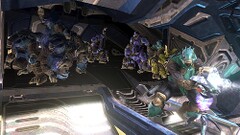
Brutes are of simian origin and have been said to resemble large gorillas, but, in some ways, they also resemble ursine, or rhinoceros as well. They have thick, gray skin, and are covered with matted, black, tan, or brown fur-like hair and some have short, black, or brown colored beards. Their large, stocky appearance is most likely due to the gravity on their planet, which is about twice the gravity of that on Earth. As they age, the hair will change to a grayish-silver color, which is a great sign of respect for all the Brutes.
They have very sharp teeth and sometimes use them as a weapon. Standing roughly 8" feet tall, John-117 barely survived a hand-to-hand battle with one, proving how physically powerful they can be. However it should be noted that John-117 and the other Spartans were suffering from the non-stop combat they had endured since the battle of Reach, with John-117 sustaining, in Doctor Halsey's words, "Burns, brain damage, fractures, and internal bleeding". The other Spartans involved in the fight had sustained various injuries from falling over two kilometers at terminal velocity onto Reach's surface. It appears that their physical strength cannot be accurately quantified.[9]
The Brutes, with the exception of Tartarus, did not use energy shielding in Halo 2. In Halo 3, all of them are equipped with Power Armor that emphasizes their natural strength and power. Brutes speak in deep, gravelly voices when speaking Human languages and speak their native language as a series of grunts, hisses, roars and deep communal howls during ceremonies and for communication.
In many military records, Brutes are referred to as 'Bravo Kilos', since UNSC Marines have nicknamed Brutes "Baby Kongs" or "Gorillas", a reference to King Kong.
Anatomy and Physiology
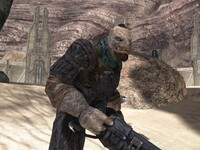
Brutes are physically imposing enemies to face in combat. Standing at approximately 8 feet tall, they not only tower over their human opponents, but the majority of their Covenant allies, with only Hunters standing taller. They have thick, gray skin that is extremely resilient to damage.
In their first appearance, they are covered in thick, shaggy fur that offers further protection. It covers most of the body except for the head and the shoulder blades. However, the Brutes in Halo 2 are shaggier than those of Halo 3. In Halo 3, the Brutes have what looks like scales on their arms, but it may have been extensions to their armor, or simply their thick skin, as seen from McFarlane action figures. Brutes exhibit two coloration's: brown and gray. This is perhaps an indication of age, since lower ranking Brutes are brown and most Honor Guards, and Tartarus himself, are Grey. In Halo 3, they are seen with shaved faces, which increase the fearful effect they have on opponents.
In Halo 3 Brutes have mixed red-and-blue blood (on first glance they look completely red, but on closer inspection one would see blue spots in pools of Brute blood). At a casual glance, it appears purple. In Halo 2, however, it appeared black. Brutes resemble a cross between an ape and a rhino, being taller and more muscular in the torso and limbs than a human.
Heavily muscled and possessing an animalistic brutality and strength, Brutes can rely on close combat to defeat their enemies, even more so than their Elite counterparts. However, their great strength may in fact be simply relative, due to the species' evolution on a world with twice the gravity of Delta Halo, Earth, and other planets and structures with one G. Featuring characteristics simian, ursine, and alien, their appearance fits their human given name.
Brutes have digits on each hand including opposable thumbs. As such they can make use of a variety of weapons both of Covenant and human design. Their feet have only two digits. The Halo 3 Tartarus figure has a red tounge but if this is canon is unkown. When it comes to ranged conflict Brutes show a tendency to use large, rapid firing, often powerful weapons. This may be indicative of their mentality and an extension of their brutal nature. The many spikes and serrated edges that adorn their race's weapons, vehicles and armor further exhibit this. It is interesting to note that in Halo 2 Jiralhanae can be seen using human Shotguns. The Brutes also wield a handgun version of the Shotgun, the Mauler, in Halo 3.
Brutes are not as mentally slow as they may appear, and are often fairly cunning tacticians. As such they can pilot vehicles & ships and command both land based & fleet encounters with strategic competence, albeit lacking in artistic flair. They also have a higher vocabulary than other members of the Covenant apart from Elites and Prophets.
Brutes are known to descend into a highly aggressive berserk killing-rage when all their pack mates have been killed. Their incredible physical strength coupled with a dogged self determination to kill their target makes a berserk Brute a force to be reckoned with, powerful enough even to kill Hunters (if they slam into the Hunter enough). Also, when berserking, they will not hesitate to attack an enemy, even if the target is in a vehicle, such as a Ghost. If the target is in a Spectre or Wraith, they will board it and attempt to kill (in a Wraith) or force the enemy out (such as in a Warthog or Spectre). Interestingly, they will neither attack nor hijack a low flying vehicle (such as a Banshee).
There is a substantial difference between the Brutes of Halo 2 and Halo 3. The Brutes of Halo 2 had very little armor, were unclothed and unshaven. The Brutes of Halo 3 were largely shaven, clothed in tight-fitting garments that reflected their rank and were adorned with Power Armor. This probably had something to do with the Brutes' new-found rank after the Elites' split from the Covenant.
The aesthetic and graphic differences between the two games also had a strong dichotomy between them, for the Brutes in Halo 2 were less detailed and less anthropoid than they were in Halo 3. This is a result of the technology available at the time the two games were made.
Given the absence of power armor at the time of Halo 2, it is possible that the Brutes that were seen were members of Tartarus's pack and/or a subset of the Jiralhanae that shunned the use of extensive protection and emphasized relying on their own strength, skill, courage, and ferocity to protect them, or that all the Brutes you encountered in Halo 2 are from Maccabeus/Tartarus' clan and were banned from wearing armor due to their failure at Harvest. It is also possible that the Brutes of Halo 2 were second in rank to the Elites and the Prophets. Following The Great Schism, the Brutes became the Prophets' main protection, and it became a necessity to outfit them with more advanced equipment.
In Halo: Contact Harvest, it is stated that before Jiralhanae reach full maturity, they naturally release pheromones. Other Jiralhanae can smell these pheromones and tell how others are feeling by the scent. When they do reach maturity, they learn to control the releases of their pheromones and most likely stop them all together.
Culture
Brutes are extremely zealous creatures, known for their willingness to cling to ancient, bloody traditions and are deep believers in the promise of the Great Journey and in the Forerunners. Their home world is war torn, and Brutes are known for their particular joy in vicious activity, complimented by regimented discipline.
They prefer using weapons from their homeworld, rather than the Covenant standard-issue plasma-based firearms. Brute weapons are notable for being extremely dangerous, somewhat primitive and brutal, and always featuring a blade attachment such as the Spiker, Mauler, Brute Shot, and the Gravity Hammer. These weapons show their barbaric nature, for example, the fact that all of the weapons are named after ways of injury or causing bodily harm to another being. Although they do have their own type of Plasma Rifle, it is only found in Halo 2 and Halo 3: ODST (the rifle is red, but fires twice as fast as its blue counterpart, also causing it to overheat twice as fast). This type of Plasma Rifle was removed in Halo 3, being replaced by the Spiker.
In general, Brutes have a pronounced dislike of the Sangheili, due to the fact that they believe that they are better protectors of the Prophets than the Elites. The Prophet of Truth took advantage of this to ignite the Great Schism during the events of Halo 2.
Society
Brutes have a fierce pack culture and lineage, a close knit affair that ties each member to another, and forces them into varying states of rage known as "berserking", and desperate mourning for their fallen pack mates should one die in the midst of battle. What a pack member kills may be the food of the pack. Each pack is led by a prominent Brute Chieftain that wields a ceremonial Gravity Hammer, passed from one leader to another upon his death, to denote his status. A Brute becomes a pack Chieftain by challenging the current Chieftain to a Mortal duel; the victor claims the title after executing the other. The chieftain rules his pack like his own little empire. Their warrior culture is extremely patriarchal, with rank measured by success on and off the battlefield, unlike the Sangheili.[3]
It is unlikely, given their combative and aggressive nature, that the Jiralhanae have a single cohesive government. Instead, Jiralhanae society can be viewed as an extension to the simply pack structure, but with a number of different levels:
- Alpha Tribes - seem to be the political body of the Jiralhanae, and are comprised of smaller Master Packs. Lead by Alpha Jiralhanae.
- Master Pack - more military oriented groups, Master-Packs are comprised of many smaller packs. Prior to contact with the Covenant, rival Master Packs reduced Jiralhanae society to a preindustrial level through warfare.
- Pack - range in size and importance, with less important packs made up largely of Unggoy or Kig-Yar forces and led by a low-ranked Jiralhanae, and more important packs led by War Chieftains and comprised of more experienced veteran Jiralhanae bodyguards.
Naming
Most, if not all Brutes, have Latin-sounding names, some examples of which are Tartarus and Bracktanus. In Contact Harvest, it is revealed that the "-us" at the end of their name is an honor denoting maturity or experience in battle (similar to the "-ee" suffix on Elite's names.) Oddly, in Halo: Ghosts of Onyx, there was a Brute Shipmaster, by the name of Gargantum, which seems to contradict this rule, although this is never explained why, along with the Brute Chieftain Parabum, appearing in the novel Halo: Evolutions in the short story Stomping on the Heels of a Fuss. Possibly it is because different clans or groups of Brutes have different naming rules.
Home World
- Main article: Doisac
Doisac is the name of the Brute home world. It possesses three satellites: Warial, Solrapt, and Teash, and is the fourth planet of the Oth Sonin system. The gravity on the planet is approximately 2.1G [3] while the atmosphere is 1.3 ATM. Surface temperature is between -15'C to 52'C. The estimated population of the planet is approximately 12.5 billion. Its habitat is described as being dominated by magma and magnetism.[10]
Rank Structure
The Brute species is arranged in a pack society, based on a hierarchy determined by viciousness and number of war kills. A “pack master” leads brute packs. A Chieftain will frequently be addressed as such while issuing orders during combat. In Halo 2, the ranks were mostly determined by red flags on their backs, the amount of armor they wore and the color of their fur (sometimes even their weapons). Like the Elites, ranks in Halo 3 are differentiated by armor color. Furthermore, the higher the rank, the more advanced and resilient the armor becomes.
| Rank | Image | Description |
| Chieftain | File:H3 Brute Chieftain Weapon.gif | These Brute Chieftains are clad in crimson/black armor and wield close-ranged Melee weapons such as Gravity Hammers. They use Invincibility, a Power Drainer, or a Flare and their Power Armor cannot be stuck by Plasma/Spike grenades or Needler needles. However, they can be stuck by Incendiary Grenades. Also, their weapon can be stuck by any sticking grenade. Identification: Black and Red Armor. |
| War Chieftain | File:H3 Brute Chieftain Armor.gif | These Brute Chieftains rely upon powerful weapons like Portable Plasma Cannons and Fuel Rod Guns to crush their foes, while often throwing or possessing Power Drains and Flares. Their armor cannot be stuck by Plasma Grenades/Spike Grenades or Needler needles. However, they can be stuck by Incendiary Grenades or their weapon can by any sticking grenade for an immediate kill. Identification: Dark Golden Armor. |
| Brute Captain Ultra | File:H3 Brute Captain Ultra.gif | The Brute Captain Ultras are the highest captain rank and use heavier weapons, such as Brute Shots and Fuel Rod Guns. Identification: Cyan/Cobalt Armor. |
| Brute Captain Major | File:H3 Brute Captain Major.gif | The Brute Captain Majors are even more experienced than their younger comrades and lead larger packs into battle. Also usually wield Brute Shots and Fuel Rods Identification: Golden Armor. |
| Brute Captain | File:H3 Brute Captain Minor.gif | The Brute Captains are experienced Brutes who now lead their comrades and the lesser races into battle. Identification: Purple-Red Armor. |
| Brute Honor Guard | File:Guardsmen2.png | Brute Honor Guards were chosen by the Prophets to replace the Honor Guard Elites as their protectors after murder of the High Prophet of Regret. They are exclusive of Halo 2 and are some of the best warriors the Brutes have. Identification: Orange, Yellow and Red Ceremonial Armor; Red Flag. |
| Brute Bodyguard | File:H3 Bodyguard.gif | Brute Bodyguards are some of the Chieftain's most reliable warriors and not only protect their chieftain but enforce his tribal law. They seem to be the Halo 3 Brute counterparts of the Honor Guard Elite Unit. Identification: Grayish-Blue/Steel Blue armor. |
| Jump Pack Brute Captain | File:Bruteultra.gif | These veteran Brutes utilize jump packs to launch aerial attacks from afar, and use their enhanced mobility for guerrilla battle tactics. They seem to be the Brute counterparts of the Ranger Elite Unit. Identification: Jump pack, Gold armor. |
| Jump Pack Brute Major | File:Brutemajor.gif | These veteran Brutes utilize jump packs to launch aerial attacks from afar, and use their enhanced mobility for guerrilla battle tactics. They seem to be the Brute counterparts of the Ranger Elite Unit. Identification: Jump pack, Red armor. |
| Jump Pack Brute Minor | File:H3 Brute Jumppack.gif | These veteran Brutes utilize jump packs to launch aerial attacks from afar, and use their enhanced mobility for guerrilla battle tactics. They seem to be the Brute counterparts of the Ranger Elite Unit. Identification: Jump pack, Blue armor. |
| Brute Stalker | File:H3 Brute Stalker.gif | Brute Stalkers are the secret police of the Brutes and specialize in stealth techniques with their Active Camouflage generators. They seem to be the Brute counterparts of the Stealth Elite unit. Identification: Grayish Black armor, Flame Grenades, Radar Jammers. |
| Brute Ultra | File:H3 Brute Ultra.gif | Brute Ultras are now armed with violet Armor, they are comprised of the best of the regular infantrymen, showing tact, cunning skill and strength. Identification: Purple-Blue/Indigo armor. |
| Brute Major | File:H3 Brute Major.gif | Brute Majors are clad in dark blue Armor and are promoted in a similar fashion to the Elites. They are promoted on the casualties they inflict. Identification: Blue armor. |
| Brute Minor | File:H3 Brute Minor.gif | Brute Minors are the lowest rank of the Brute race, clad in turquoise Armor and typically armed with the Type-25 Carbine. Not only do they compete for their posting but also for their equipment. Identification: Teal-Green armor, unarmored in Halo 2. |
Also in Halo 2, Brute Minors are seen with little to no armor, the only armor being a helmet-like head plate which, ironically, gives no protection from headshots from even the weaker weapons such as the Plasma Pistol and Magnum. It is known they do not switch weapons at any time.
Other Ranks
Chieftain of the Jiralhanae - The Leader of the entire Jiralhanae race. Both Maccabeus and Tartarus were of this rank. Since Tartarus was killed in the Battle of Installation 05, the current Chieftain is unknown, if there is one at all.
Brute Ship Master/Alpha Jiralhanae - Commanders of ships. They may be equivalent to Captains or Chieftains of the Jiralhanae.
Brute Army Commander - Only in Halo Wars, probably same rank or near same rank as Chieftain of the Jiralhanae. May be a specific rank created for war and conflict, such as the Human-Covenant war.
Gameplay
- Main article: Jiralhanae/Gameplay
Unlike Elites, who are masterfully skilled tacticians, the Brute combat mentality relies on overwhelming force, sheer strength, and incredibly strong firepower, hence the name "Brute". They are easily enraged, and when provoked, will drop their weapon and charge their opponent.
Trivia
- During concept stages for Halo 3, the Brutes were planned to use deployable metal shields, rather than the energy shields used by Elites. This idea was eventually cut from the final game, although it would inspire the Brutes ducking animation.[11]
- Before Halo 3 was released, Brutes had lime green blood instead of the dark purple/red blood they have in the final game.
- In Halo 3: ODST the power armor of the Brutes completely lights up instead of small sparks marking where gun fire hits their armor like in Halo 3. This makes them similar to Elite and Spartan-II Energy Shields.
- In Contact Harvest, it is said that the honorable way to finish off one's relative when battling to the death for leadership rights to become the next Chieftain is to use their ceremonial dagger to slice their opponent's throat.
- According to First Strike, Brutes were first encountered by Spartan-II personnel aboard the Unyielding Hierophant. However, the events of Contact Harvest and Halo Wars make it clear that Brutes were encountered by humanity in general much earlier.
- The Brutes are referred to as "Bravo kilos" by Marines, by which they actually mean "Baby Kongs" for their Gorilla-like appearance.
- The word "Jiralhanae" is a Korean word, meaning something in the league of a "stupid aggressive lunatic", which almost perfectly describes the Brutes' aggressive personality.[12]
- Brutes were the first Covenant creatures encountered by humanity on peaceful terms, though this was short lived.
- In the ViDoc, Et Tu Brute, Chris Butcher describes the Brutes in Halo 2 as "damage sponges", referring to how they weren't very interesting to fight against, acting mainly like less agile Elites who dropped their guns and ran straight into you when they got angry. The ViDoc shows Brutes wielding Energy Swords; however they are never seen doing so in either game. Et Tu Brute also shows a Brute Minor with a Brute Shot using the corpse of another Brute as cover from which to fire from, and another tearing the arms off a captured Marine and a Brute Chieftain wielding a Plasma Cannon is wielding the version from Halo 2.
- Servus is Latin for slave. Ferox means "headstrong, spirited, courageous, warlike/wild, arrogant, unbridled, or belligerent". In a translation, their name means "headstrong slave", likely a nudge at their devout faith in the Great Journey.
- In Halo 2, it is possible to find Brutes wielding Human Shotguns. This is the only in-game instance of a Covenant member making use of Human weaponry by default.
- In Halo 2, Brute blood is a dark shade of blue, while it is red with blue splotches in Halo 3.
- Brutus was the one who betrayed and killed Julius Caesar, and was later hunted down by Rome. This is similar to how the Brutes betrayed the Elites and were eventually defeated. "Brute" is also a literal translation from the Covenant language when spoken by Covenant characters.
- John DiMaggio provided the voice for the Brute Chieftains in Halo 3 and Halo 3: ODST.
- The "-us" suffix on the end of Brute names is actually a Latin noun ending, which designates something as masculine.
- Although in Contact Harvest the Brutes wear the armor that they wear in Halo 3, the armor changes for some reason in Halo 2. For example, Tartarus wore the Red Captain armor but it disappears in Halo 2. This may be accounted for the fact that the Brutes were added "a little too late" (according to Et Tu Brute) in Halo 2. Nonetheless, the question remains of why the Brutes gave up their power armor. The Brutes seen in Halo Wars also wear the Halo 3 Brute armor. This is most likely because Tartarus' pack had a different armor code.
- Halo Wars was the first game to have the Brutes, or any Covenant species for that matter, mentioned by their actual name rather than their human equivalent. This is when they are encountered on the level, Anders' Signal. Serina describes them as Jiralhanae, then states that they are also known as Brutes.
- In the Halo Legends episode The Package, Brutes are depicted without their armor, have green blood, and appear to be less resilient to ballistic damage than in the games.
- In The Package, Brutes are shown commanding squads of Grunts and Jackals instead of Elites on an Elite controlled ship. It is unknown why they would be commanding squads on an Elite controlled ship if both species display such a strong hatred for each other. Throughout the episode, no Elites are seen fighting the spartans (with the exception of Thel Vadam and his team of Elites), only Brutes, Grunts and Jackals.
- The Jiralhanae species have been compared with the Romans. Their nickname "Brute" originates from the Shakespearean line "Et tu, Brute? Then fall, Caesar!". Towards the end of the Roman republic, Marcus Julius Brutus and his followers assassinate their dictator Gais Julius Caesar over political opposition. This can be compared to when Tartarus killed his uncle Maccabeus over political reasons (Tartarus believed he had a right to become the new Chieftain). Both Brutus and Tartarus would be killed in a civil war.
Glitches
- Main article: Glitches
- In Halo 2, if a berserk Brute charges into a group of fixed objects it will continue its charging animation, but it will remain where it is.
- In Halo 3, if any Brute becomes infected by the Flood he will turn into a Flood-infected Brute Minor due to graphical restraints. However, if the player triggers a loading point that removes the Flood from the level while a Infection Form has begun the infection process, the Flood Infection Form will be deleted, the infection process will be stopped yet the transformation will simultaneously complete. This will result in infected Brutes who are allied with the Flood while retaining berserking, appearance, and hijacking abilities. The only noticeable Flood features are signs of Flood infection growing on their back. The only known instance of half-infected Brutes is on The Covenant.
- In Halo 3, if a Brute Chieftain with a Plasma Cannon goes berserk, the Plasma Cannon disappears. When the Chieftain is killed, the same Plasma Cannon it had reappears by its body. This is due that the support weapon has no "putting away" animation. This has been fixed in Halo 3: ODST - if the War Chieftain goes berserk, the Plasma Cannon will hang across his back just like a normal two-handed weapon.
Gallery
- 1207645687 1166618976.jpg
A Brute Chieftain wielding an Energy Sword (this instance was never actually used as default in Halo 3, but rather in the video Et tu Brute).
The Halo 3 CGI TV trailer "Starry Night" depicts multiple Brute variants that appear in Halo 3.[13]
- 285910 f260.jpg
A few examples of Brute weaponry.
- Weirdbrutes.jpg
Two Brutes in a non-combat situation as seen in Halo 3.
- Brute 1024.jpg
A Brute Chieftain, circa 2531 (as seen in Halo Wars).
A pack of Brutes in the Halo: Reach Firefight trailer.
A Jiralhanae as seen in the Bestiarum.
Sources
- ^ http://forums.bungie.org/halo/archive29.pl?read=865756
- ^ Halo: Contact Harvest, Page 194
- ^ a b c d Halo 3 Bestiarum
- ^ Halo:Contact Harvest
- ^ a b Halo: Contact Harvest
- ^ The Arbiter, Halo 2-"Them? What about us? My belly aches, and his flesh is seared just the way I like it."
- ^ Halo: Ghosts of Onyx
- ^ Halo: Evolutions - Essential Tales of the Halo Universe, "The Return"
- ^ Halo 2 Collector's Edition Game Manual
- ^ Halo 3, Essentials Disk 1
- ^ http://www.bungie.net/News/content.aspx?type=topnews&link=Animation_BillOBrien
- ^ http://en.wikipedia.org/w/index.php?title=Talk:Covenant_%28Halo%29&diff=next&oldid=45665662
- ^ http://carnage.bungie.org/haloforum/halo.forum.pl?read=765343
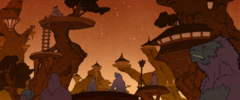
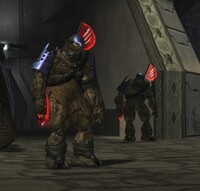
![The Halo 3 CGI TV trailer "Starry Night" depicts multiple Brute variants that appear in Halo 3.[13]](https://halo.wiki.gallery/images/thumb/8/82/Halo3_Brutes.png/200px-Halo3_Brutes.png)
